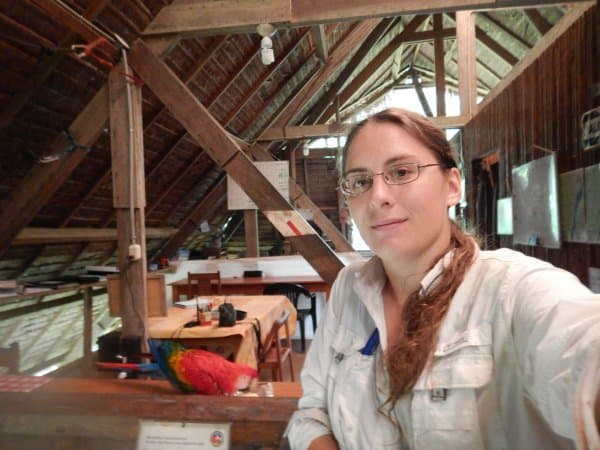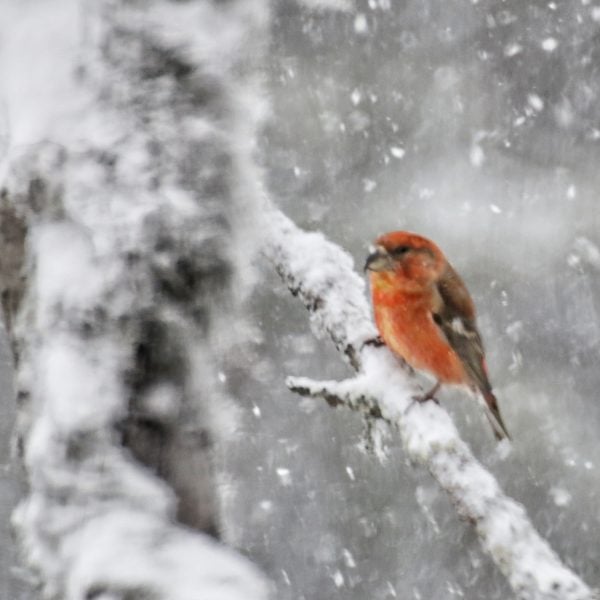Last Updated on by Catherine Tobsing
Did you know the sun conure may be facing extinction in the wild, and you can help? There is a real need for more surveys to establish their status in nature. The 2014 estimates published on the IUCN database are between 1,000 and 1,499 mature birds. Some of the last known sun conures live in Guyana, a country with a small human population and a lot of forest and savannah grasslands.
The IUCN page mentions that the trade in wild conures is “ongoing” because “due to the ease with which birds can be attracted to bait (e.g. corn) and the large distances they will travel, it is easy to trap all the individuals in an area.” Quoted from Jamie Gilardi.
 Constance Woodman gets a visitor
Constance Woodman gets a visitor
at the rainforest research station office in Peru
Drs. Michael Braun and Brian Coyle from the Smithsonian Institute have worked with the Red Siskin Initiative and are now working with PhD Student Contance Woodman of the Schubot Exotic Bird Heath Center at Texas A&M University. They’re idea is to see if the resources from the Red Siskin Initiative could be expanded to help sun conures; sometimes called sun parakeet by scientists.
The chance that Sun Conures in Guyana will recover without assistance is small. The aim of this project is to have a genetically responsible breed and release population in place before international trade in Sun Conures is shut down by a future CITES I listing, which would inhibit conservation efforts through limited international movement.
A need identified by BirdLife International, a major species conservation research organization, is to “Establish ‘pure bred’ captive-breeding lines.” Right now, it is legal to move sun conures internationally. And sun conures can be very prolific often producing more than ten chicks in a year! So creating a breeding population for conservation in Guyana would seem easy. But, right now, there are no captive sun conures at the Guyana Georgetown zoo, or any others associated with ecotourism.
Keep the Suns shining in Guyana!
Crowdfund the science that you know matters at Experiment.com.
To start a captive population for conservation, the genetics of sun conures needs to be established to weed-out any hybrids, as this species can breed with Sulphur-breasted conures or Jenday conures and others. Many groups of captive conures may be closely related; this can cause problems if relatives breed and produce offspring. The team only wants to breed birds that originate from Guyana because they will have the best chance for successful reintroduction and integration with wild populations.
Through the Smithsonian institute it would be possible to do DNA tests on bird skins currently held in museums and find out what kinds of genetics historically were found in Guyana, as well as identifying which birds are the right sun conures to breed for conservation, scientifically based on their genes. Afterwhich, utilizing Constance’s experience working at the Tambopata macaw project, the goal would be to use a captive breeding project as an ecotourism attraction, perhaps in partnership with Amerindian owned tourism lodges. By using these friendly, interactive, birds as ambassadors for their wild cousins, there could be support for local people and the formation of a backup population of conures if a program including “breed and release” ends up being necessary.
If you have pet conures, or you simply love and care about wild parrots, consider a small donation and sharing this blog post to help raise awareness for the need for parrot science! Visit https://experiment.com/projects/conures to learn more and keep the “Suns shining in Guyana!”
Author Profile
Latest entries
 The Traveling BirdJune 26, 2025Can You Name 5 Parrot Species That Are Living Wild in the USA?
The Traveling BirdJune 26, 2025Can You Name 5 Parrot Species That Are Living Wild in the USA? Bird BehaviorJune 26, 2025How is it Parrots Are Problem Solvers Social Animals and Even Use Tools?
Bird BehaviorJune 26, 2025How is it Parrots Are Problem Solvers Social Animals and Even Use Tools? Bird & Parrot AnatomyJune 25, 2025How a Tiny Chemical Modification Makes Parrots Nature’s Living Paintings
Bird & Parrot AnatomyJune 25, 2025How a Tiny Chemical Modification Makes Parrots Nature’s Living Paintings PigeonsJune 20, 2025How Do Parrots Thrive in Cities Outside Their Native Habitats?
PigeonsJune 20, 2025How Do Parrots Thrive in Cities Outside Their Native Habitats?




